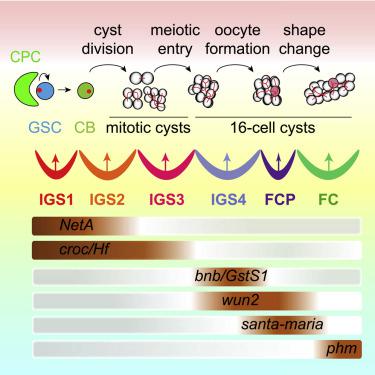Current Biology ( IF 8.1 ) Pub Date : 2020-12-23 , DOI: 10.1016/j.cub.2020.12.024 Renjun Tu 1 , Bo Duan 1 , Xiaoqing Song 1 , Shiyuan Chen 1 , Allison Scott 1 , Kate Hall 1 , Jillian Blanck 1 , Dustin DeGraffenreid 1 , Hua Li 1 , Anoja Perera 1 , Jeff Haug 1 , Ting Xie 2

|
The niche controls stem cell self-renewal and progenitor differentiation for maintaining adult tissue homeostasis in various organisms. However, it remains unclear whether the niche is compartmentalized to control stem cell self-renewal and stepwise progeny differentiation. In the Drosophila ovary, inner germarial sheath (IGS) cells form a niche for controlling germline stem cell (GSC) progeny differentiation. In this study, we have identified four IGS subpopulations, which form linearly arranged niche compartments for controlling GSC maintenance and multi-step progeny differentiation. Single-cell analysis of the adult ovary has identified four IGS subpopulations (IGS1–IGS4), the identities and cellular locations of which have been further confirmed by fluorescent in situ hybridization. IGS1 and IGS2 physically interact with GSCs and mitotic cysts to control GSC maintenance and cyst formation, respectively, whereas IGS3 and IGS4 physically interact with 16-cell cysts to regulate meiosis, oocyte development, and cyst morphological change. Finally, one follicle cell progenitor population has also been transcriptionally defined for facilitating future studies on follicle stem cell regulation. Therefore, this study has structurally revealed that the niche is organized into multiple compartments for orchestrating stepwise adult stem cell development and has also provided useful resources and tools for further functional characterization of the niche in the future.
中文翻译:

多个利基隔间协调逐步的生殖系干细胞后代分化
生态位控制干细胞自我更新和祖细胞分化,以维持各种生物体中的成体组织稳态。然而,目前尚不清楚生态位是否被划分以控制干细胞自我更新和逐步后代分化。在果蝇卵巢中,内胚鞘 (IGS) 细胞形成了控制生殖系干细胞 (GSC) 后代分化的生态位。在这项研究中,我们确定了四个 IGS 亚群,它们形成线性排列的生态位隔间,用于控制 GSC 维持和多步后代分化。成人卵巢的单细胞分析确定了四个 IGS 亚群(IGS1-IGS4),其身份和细胞位置已通过原位荧光进一步证实杂交。IGS1 和 IGS2 与 GSC 和有丝分裂囊肿物理相互作用以分别控制 GSC 维持和囊肿形成,而 IGS3 和 IGS4 与 16 细胞囊肿物理相互作用以调节减数分裂、卵母细胞发育和囊肿形态变化。最后,一个卵泡细胞祖细胞群也已被转录定义,以促进未来对卵泡干细胞调控的研究。因此,本研究在结构上揭示了生态位被组织成多个隔间以协调逐步成体干细胞发育,并且还为未来进一步的生态位功能表征提供了有用的资源和工具。











































 京公网安备 11010802027423号
京公网安备 11010802027423号